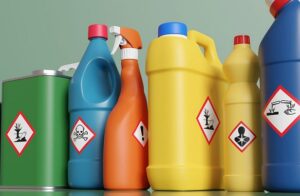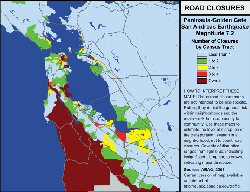Many people know that ammonia mixed with bleach creates a toxic gas. Therefore we should not only not mix them to clean, we should store them apart from each other to they can’t spill and mix during the shaking of an earthquake.
They are fine if handled carefully (read the instructions and follow them) and only used sparingly in a well ventilated area, but are quite toxic, even lethal, if mixed or spilled in a large enough quantity on skin or in a quantity that is breathed in.
Are the lids always put back on tightly each time you use them?

Never pour undiluted bleach straight from the bottle onto spills you need to clean up of blood, urine, sputum or vomit. Dangerous levels of toxic nitrous oxide gases could result.
Here are some mixtures to avoid, but not a comprehensive list: (from the Campbell Community Emergency Response Team training)
The aforementioned household ammonia with bleach or with pool acid, or Liquid Plumber.
Clorox (or other bleach) with toilet bowl cleaners, swimming pool acid, ammonia, rust remover, or any acid-type substance.
Oven cleaners have sodium hydroxide (lye) and will cause extreme heat if mixed with sulfuric acid (like Liquid Plumber) or hydrochloric acid (like toilet bowl cleaner). The fumes from lye alone are dangerous to contact lens wearers and mucous membranes. Lye can cause burns.
Liquid Plumber and many other drain openers contain sulfuric acid and when mixed with bleach, pool chlorine or any other chlorine-based substance can create chlorine gas (as used in chemical warfare). Have some patience using the drain cleaners, and do not mix various brands by using one right after the other. (Follow the directions on the package.)
Paint remover that contains methylene chloride (a known cancer causing agent) may rupture violently during a fire. It should not be stored In your house.
Raid is flammable around heat or open flame. It contains a chemical that can cause aspiration pneumonia if breathed in quantity.
Ortho dormant spray contains calcium polysulfide. When it comes in contact with any acid-type chemical it could give off a highly toxic, extremely flammable gas.
Just about any household or garden pesticide or herbicide, when mixed together in large quantities, can become dangerous.
Store all these with hazards in mind. They should all be on a floor level shelf so any earthquake shaking motion will affect them less. The shelf, cabinet or shelves should be anchored to the wall with some type of restraint across the front of the shelf to prevent bottles from falling.
Pesticides, pool cleaners, etc. should not be IN your house.
Store, use and dispose of all chemicals according to the instructions on the original container.
Keep all medicines, cosmetics, cleaning products, and other household chemicals out of sight, tightly capped, and out of reach of children.
Buy only as much as you will need to use so you don’t have to store extras.
Poison control can be contacted for emergency information about swallowing poisons, eye or skin irritation from poisonous substances, inhalation of poisonous fumes (and more) at 1 800 222-1222. You might want to put the number right next to the phone(s).
______________________________________________
The CDC (Centers for Disease Control) warns: Follow your local solid waste authority’s guidance for disposal of broken, leaking, empty, or unlabeled chemical containers. Do not throw them away with your regular trash.
see also:
earthquake home hazards survey
You can find detailed maps (with zoom in capability) of potential road closures, risk of liquefaction and flooding, such as this map of potential Bay Area road closures after a San Andreas fault 7.2 quake,

at the ABAG link at: Earthquake information sources
Helping Children Cope With Disaster
Store water for after an earthquake
Babysitter Consent and Contact Form
Fast, easy, cheap earthquake preparedness
Earthquake and pets advice (Consider having the vet ‘microchip’ your pets, and more…)
The author of this webpage, (written as a homework reading assignment for my students), does not give any warranty, expressed or implied, nor assume any legal liability or responsibility for the accuracy, completeness, or usefulness of any information, product, or process included in this website or at websites linked to or from it. Users of information from this website assume all liability arising from such use.